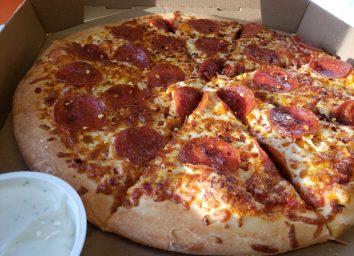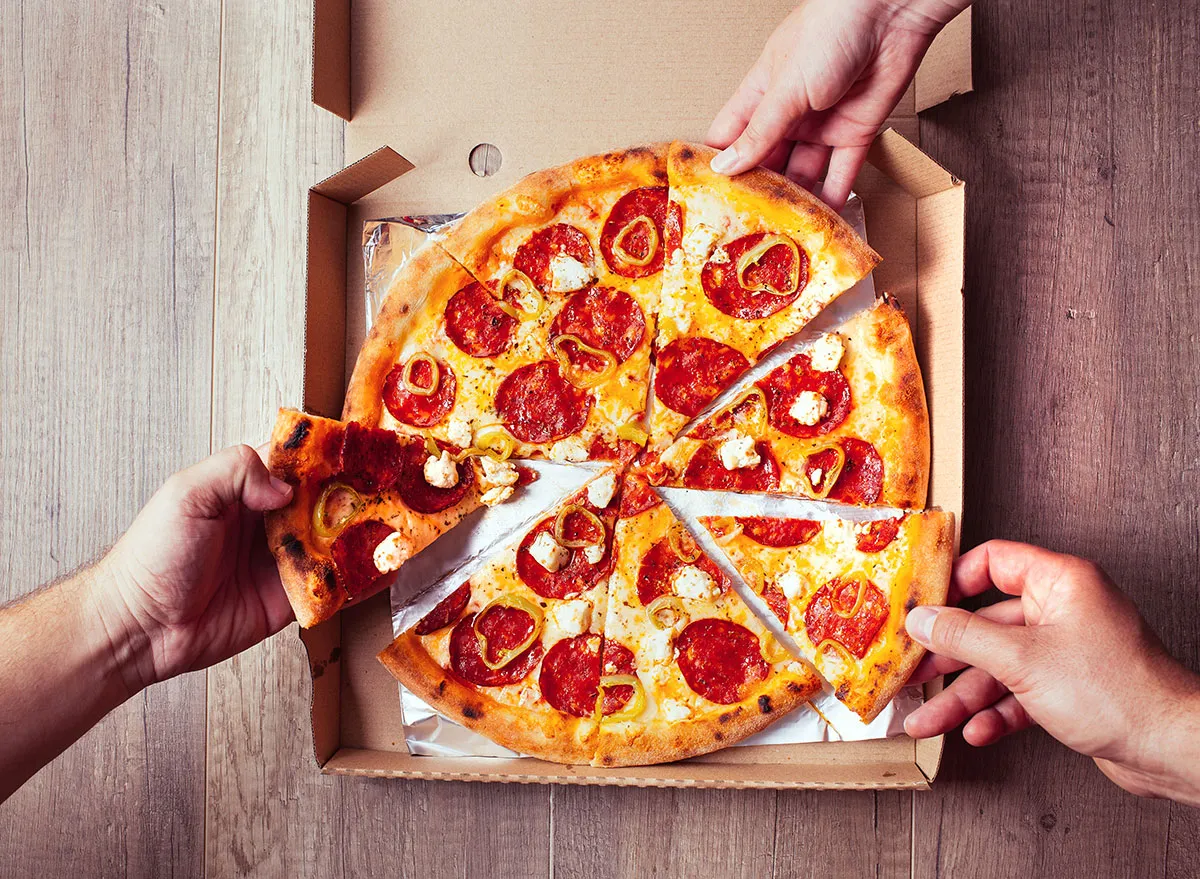
All pizzas are not created equal. If they were, there wouldn't be such a scorching war between Midwestern deep dish and folded East Coast slice camps; timeless and heated debates on the superiority of Sicilian over Neapolitan or vice versa; nor blistering arguments over what order cheese and sauce are layered, not to mention the types of sauce and cheese. It's these details that set different regions and brands apart … and what makes the big names famous. But what's the difference between the major national chain brands? And most importantly, which chain has the best-tasting plain cheese pizza?
To find out, a panel of tasters from across the country (read: plenty of diverse, divergent preferences, biases, and backgrounds) was assembled for a totally blind taste test of original pizzas from seven big-name national chains … with emphasis on "original." What this means is that we did not order all of the pizzas with the same crust style; rather, whether their claim to fame was hand-tossed or pan-baked, we judged them based on the signature pie that gave them a foothold in the national market. (Plus, don't miss We Tasted 8 Hot Dog Brands & This Is the Best!)
Methodology

Let's be honest—most of us, when we're ordering pizza these days, we're getting it delivered. But to ensure that we were tasting all of them at roughly the same quality and at the same time, we picked them up individually, which added up to as much time spent cooling in the box as if we'd called them in. We also tasted each of them three times at three different temperatures to account for these preferences and ways of eating. We tried them warm out of the box for that day-of experience; as cold "breakfast slices," as one tester jokingly called his favorite method; and for that fresh-baked experience, reheated in a gas convection oven on a cookie sheet at 350 degrees Fahrenheit. These rankings reflect overall performance across all three styles.
Little Caesars
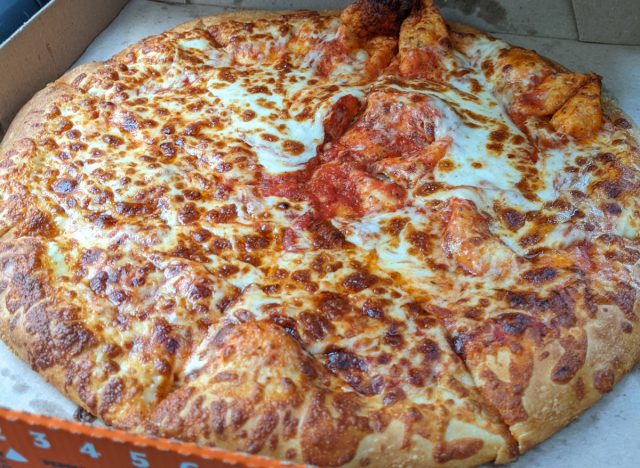
As the meme goes, "It's hot and it's ready." "Is it good?" "It's HOT. And it's READY." In all, this pretty much sums it up, and I'm pretty disappointed to rank it dead last. Personally, I have such fond memories of my mom promising us Little Caesars pizza on the way out of K-Mart if we were well-behaved, those rough grains of coarse cornmeal bright and yellow beneath pliant dough. Unfortunately, several locations like the one we ordered from have switched over to VegaLube, per employee comments on Reddit, and it's for the worse. This texture used to offer a distraction from the monotony of a mechanical-tasting, flour-and-water crust, and without it, falls as flat as the pita bread-smooth bottom itself. Meanwhile, the top was malformed and bubbled up unevenly.
"The whole thing is just rubbery," complained one taster, who later decried the graininess the cheese developed when reheated. This was unexpected since their cheese is fresh and never frozen, and a blend of mozzarella and Muenster. "There's a weird aftertaste I can't get over," said another, which was strange since the actual eating lacked any distinguishing flavor at all. "I feel like I'm just chewing something; there's something in my mouth," a panelist aptly put it.
The Deep! Deep! And ExtraMostBestest with the stuffed crust are rumored to be considerably better, but the baseline is unfortunately exactly what you're paying $5.55 for.
Marco's Pizza
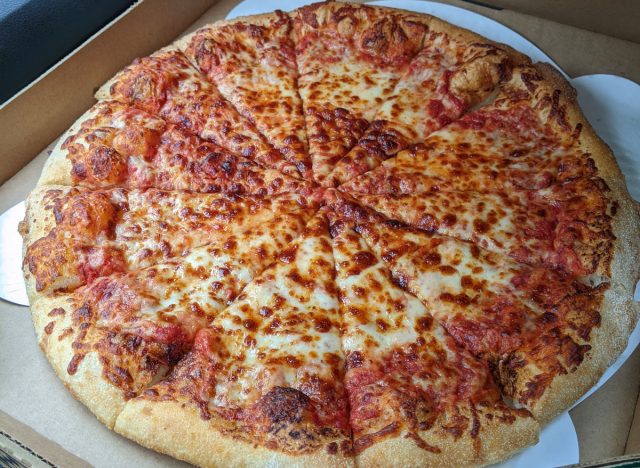
We wanted to like this one. We really did. The friendly owner of the local Marco's was quick to share of this lesser-known brand that all ingredients are fresh and never frozen, and had helpfully attached coupons to the outside of the box and information on rewards. Unfortunately, we won't be earning loyalty points with this one, since it was regrettably disappointing.
The cornmeal Little Caesars no longer uses on their base has found a new home at this brand, whose crusts can also come enhanced with Roma, parmesan, garlic, Roma seasoning, or Romasan flavors. To keep things fair and to better taste the virgin dough, we went with plain on the $12.99 extra-large 12-slice … and understood why the enhancements are offered. The pizza itself is very soft with lots of chewy crust, undercooked in spots and generally uneven. We found the sauce very sweet, like jarred Ragu brand with a little extra oregano and salt. "It's just very blah from every angle," remarked one taster. Another added, "Also a little spongy, especially as the cheese cools."
Domino's
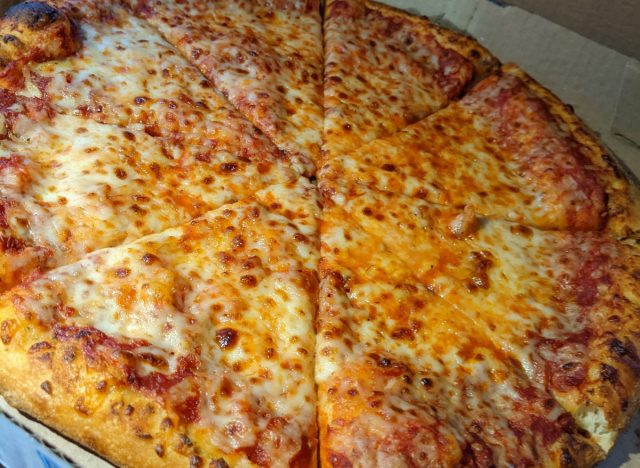
Giving credit where credit's due, this major brand's major-er mea culpa in 2008 was a bold move in hat-in-hand accountability. It was amid complaints of "cardboard crust" pizza with "ketchup"-like sauce that they started over, adding garlic-herb seasoning to the crust, a sweeter sauce with a whisper of pepper, and a shredded provolone and mozzarella blend. But were these changes enough to earn them the pizza chain crown again? According to our panel, it's a resounding no.
The dry, papery crust of our 14-inch large hand-tossed pizza still had its issues. "It just separates," noticed one taster, lifting off the browned part to reveal a crumb that spiked vaguely upward, undisturbed and remaining in place like fiberglass insulation. The bottom of it was heavily floured, so much that the taste of raw flour was apparent. "It tastes like a floury hard pretzel, a little," but without the alkaline complexity. And while the sauce and the cheese offered a slight sharpness that others lacked, creating potential interest, there wasn't enough of either to distract from the failure of the crust. The layers of both were meager, and all dried up into a powdery graininess on the reheat. The touch of garlic was even more subtle; "This is why you always have to get extra," my absent brother advised when I told him how it performed. However, if you have to get extra everything, in our opinion, that means the original as-is recipe is seriously lacking in commitment.
Papa John's
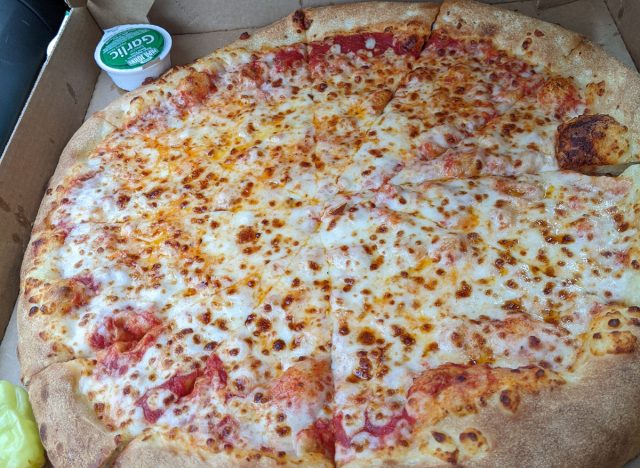
"Most pizza chains have a signature flavor, but the question is, do you like that signature flavor?" queried one taster. In his case, the answer was "no" for the good ol' Papa, but others such as myself and several other members of the tasting group, the extra-large hand-tossed was pretty fine. It was among the priciest–a side effect of the "better ingredients" the brand touts–but the proportion of border crust to actual pizza leaves value to be desired. It's even more pronounced in the admittedly super-cheesy stuffed crust, but there's just a lot of it. Sweet, yeasty, pale, and slightly crispy on the surface but soft inside, it's almost like a hot supermarket bagel. "This feels like a breadstick; I can see this being good dipped in garlic," said one panelist, to my immense amusement since the brand does provide garlic dipping sauce (and pepperoncini) as a default accompaniment to every pie.
This lack of lubricant was a theme that continued into the middle of the pizza, as we asked: "Where's the sauce?" What little there was, was SpaghettiO's sweet. The cheese was fine, mild, and unremarkable, but overall, "it tastes like they added sugar to it," a point several couldn't get over. This proved to be the most polarizing aspect, with some embracing it and resigning the excessive crust to a dunking vehicle for butter or tomatoes and others cringing. "It's different in the Northeast, though!" protested an out-of-town panelist and brand fan when the maker was revealed … but a lack of consistency is not the greatest defense.
Costco/Kirkland Food Court
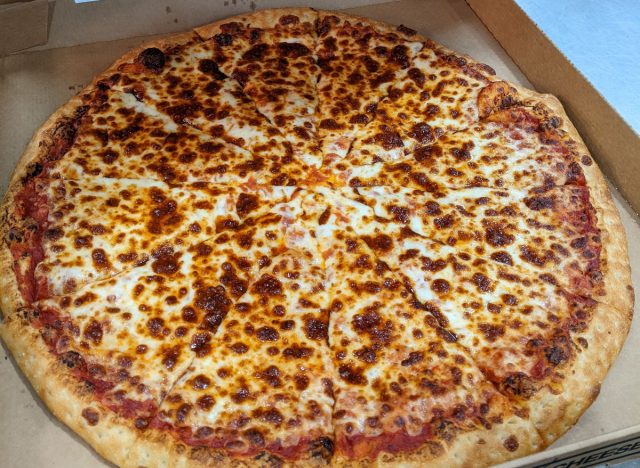
Surprised to see this pick-up-only warehouse pizzeria on the list? Don't be—Costco is actually considered in the food industry as one of the most major chains in the country, which is why we took a special trip to include them in this taste test. They measure 18 inches across, which is considered generous (if you're not from New York, where that size is pretty standard). And for $9.99 each, it's even more so. But the most wow-worthy fact of it all? It's actually very good.
The dough is hand-stretched and perforated for aeration and even baking before it's covered in a pound and a half of mozzarella and provolone. The thickness of this coating of gooey, full-fat cheese led to a pizza that was rich, full, and unctuous, stretching out pristinely white and long underneath a brown freckled surface that at first, looks like it might be overcooked. "It does the stringy-thingy!" exclaimed one panelist with joy, as everyone nodded to the obvious statement, "there's so much cheese." This quality cheese blend made it so that folks stopped caring about the fact that the crust was chewy and soft, more akin to bread than proper pizza crust. However, this is a pizza worth the bulk buy, as the crust improves with rebaking, crisping up properly, and with no detriment to the still silky cheese. With just enough smooth sauce, whose concentrated tomato flavor was just acidic enough to balance out the creaminess of the topping, this is where the taste test took a significant turn for the better, marking the line of division between "okay, I guess" to "really great."
Pizza Hut
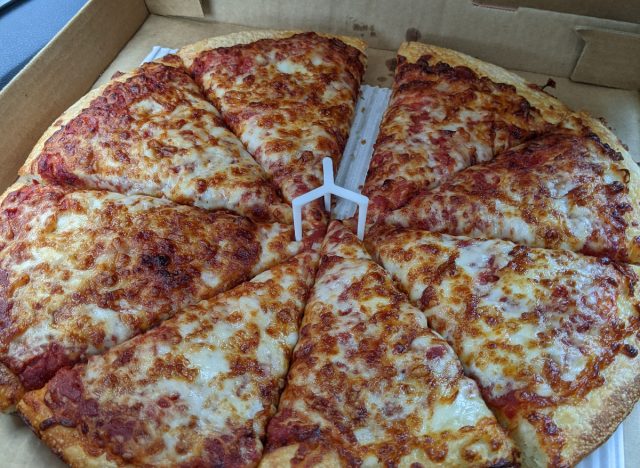
"Nobody out-pizzas the Hut," the brand boldly proclaims, and against the other major national franchises, this ended up being pretty close to totally true. Going into this, I was worried that it was too distinctive ("This smells like Pizza Hut," one panelist sniffed, "… But don't tell me!") or that my own tasting would be clouded by nostalgia, with memories of tiny pan pizzas eaten in a booth and earned with my Book-It program certificates. However, it was a joy to discover that my childhood memories were not better than the real deal, since—although we picked it up—Pizza Hut delivered.
It's one of the pricier ones at $15 for a small-ish large, and like the Costco one, looked a little overcooked at first glance. But actually, it proved to be perfect, with a thicker crust that avoided being spongey or doughy. Rather, there was a gorgeous crunch to the large $15 pizza, crisping up golden along the outside surfaces as it absorbed all the heat and all the richness of the fat the signature pan is greased with. You smell it before you even taste it, wafting up buttery and divine.
"It's simultaneously crispy and soft," one tester said in happy wonder, "and so full of flavor!" In fact, it was delicious enough that it closely beat out Costco's cheese appeal with the rationale that "we could always just add on extra cheese and have an ideal big-chain pizza." The cheese that was on the pie was fine—a little dry cold and reheated, but perfectly acceptable-tasting. And although their "Zesty" sauce is no longer with us, we appreciate that their regular one is savory and herbaceous, with a deep tomato flavor that satisfies.
Jet's Pizza
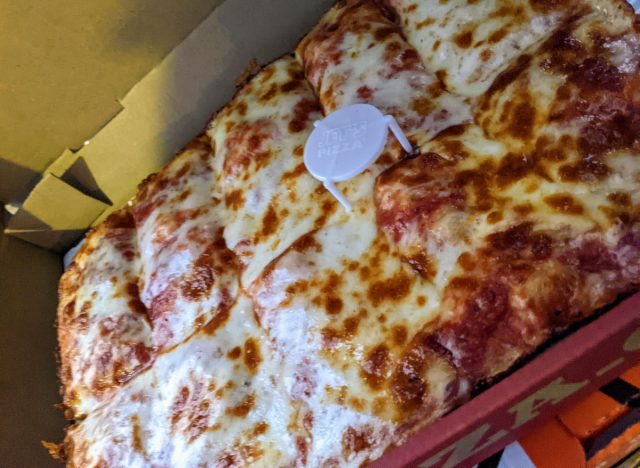
I am 100% expecting technical pushback on this one, as even one panelist asked, "Wait, is this a Sicilian?" However, the caveat was that we were tasting the type that made the brand famous, and for Midwestern Jet's Pizza, it's their signature Detroit-style pie, with cheese spread to the very edge of the pan-baked crust for a lacy skirt of toasted shreds. Like the runner-up, this was also $15 and smaller than the others, but what it lacks in breadth, it more than makes up in heft.
"There's such an abundance of all three elements!" exclaimed the very excited panel when they first laid eyes on the unblemished, bright white cheese that oozed tantalizingly off the center cuts. "I want that one,"—with a full finger-point—was an enthusiastic response to the assembled slices in the initial blind test. And it was just as good, and perhaps even better, than it looked.
Because of its thickness, it retained its moisture, the crust steaming beneath the thick, heavy cloud of silky cheese to create a slightly sweet, doughy texture that yet retained its bite. The cheese was pure and clean-tasting, as was the sauce, which was simple, light, and tasted of crushed summertime tomatoes. Meanwhile, the bottom and non-cheesed edges of the crust were buttery and rich, but not as overtly nor fragrantly as Pizza Hut's. But this was by no means a bad thing, since all components were honestly ideally balanced—the hallmark of a dish well done. However, should you ever want a bit more from that already delicious crust, there are a plethora of crust enhancement options available, from sesame to poppy seed to cheese to even Cajun and what they call their "Turbo Crust" seasoning blend. These flavors might get a bit lost in the cheese edge, but the brand has also branched out into thin, hand-tossed, New York-style, cauliflower, and gluten-free crusts … if you can tear yourself away from the temptation of their excellent original.
The Takeaway
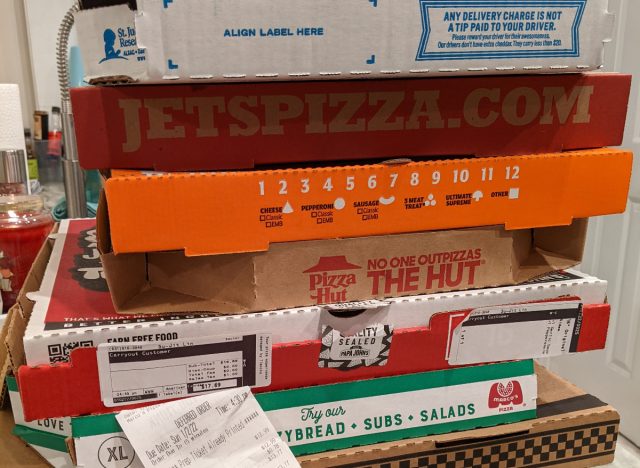
It should be assumed that no national franchise pizza chain is "bad." In order for them to have scaled up to the levels they have, they must arguably have virtues that make them stand out. However, while the combination of risen dough, cooked tomatoes, and white cheese is undisputedly one of the greatest things mankind has come up with, ingredients, proportion, and technique can make or break this simple formula. Freshness doesn't mean anything if that equation is off and there is very little middle ground between pizza that is a chore and pizza that is a pleasure. The divide is great and obvious when tasted side by side, where, in most cases, the budget-brand pizza chains that market and sell to economy, taste like it. Some chains err too far on the side of sweetness, pandering to our sugar-addicted palates in an overtly obvious fashion. But what we found, in a panel comprised of New Yorkers, Southerners, and West Coasters, is that universally, a rich, fatty bite—whether it's creamy, gooey cheese or a buttery crust—is what unites and satisfies.
Browse more taste tests:
We Tasted Every Taco at Taco Bell & This Is the Best
We Tried 6 Store-Bought Rotisserie Chickens & This Is the Best

